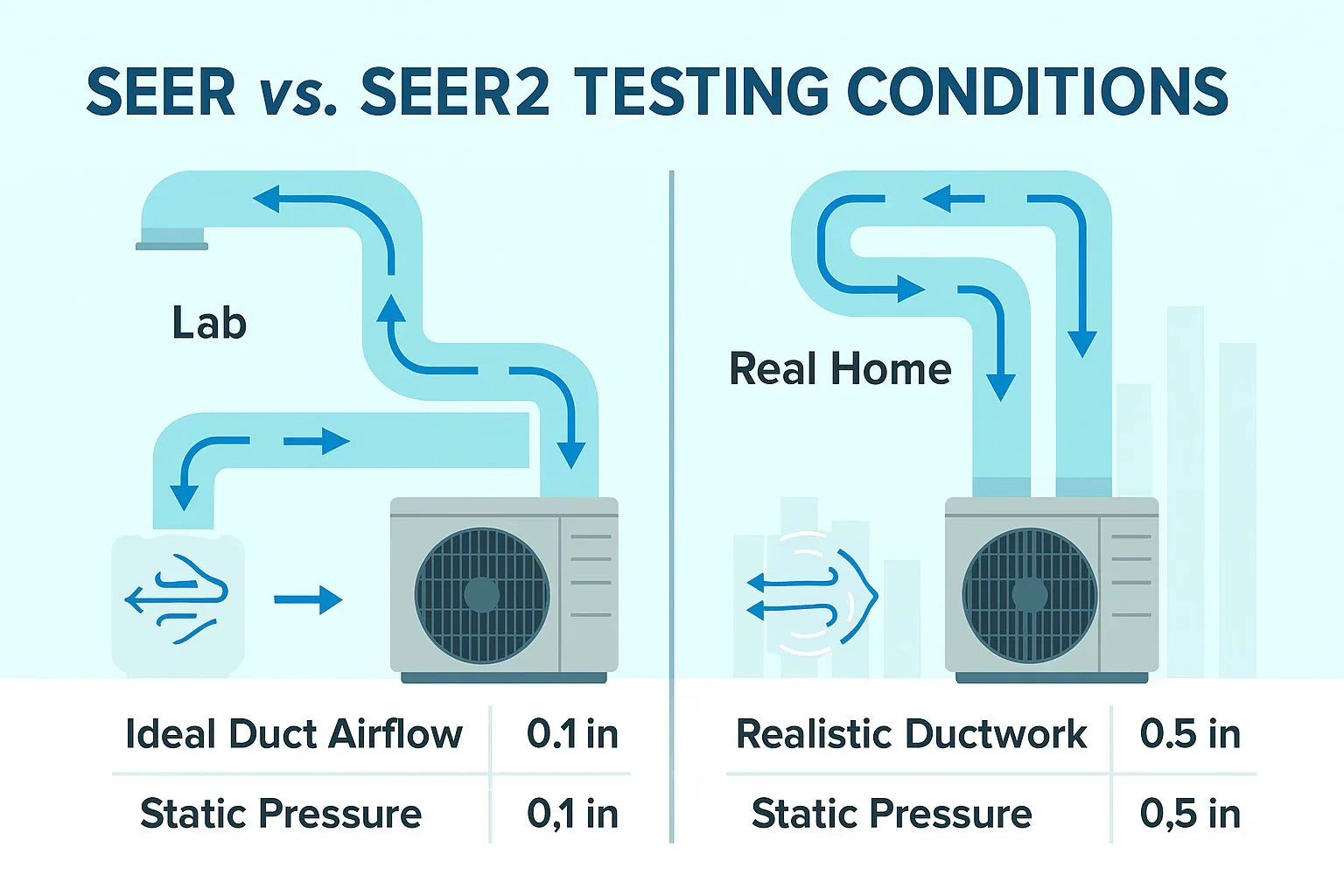Alex Lane | Your Home Comfort Advocate
If you're shopping for a new air conditioner or heat pump in 2025, chances are you've run into the term SEER2. It’s not just a rebranding of the old SEER rating—it’s a major update that changes how efficiency is tested and how real-world performance is measured.
Whether you're replacing an aging unit or just trying to make sense of energy labels, this guide breaks down what SEER2 is, why it matters for your comfort and energy bills, and how it helps you make smarter HVAC choices.
🔧 What Does SEER2 Mean?
SEER2 stands for Seasonal Energy Efficiency Ratio 2. It’s the updated version of SEER, the long-time standard for measuring how efficiently central air conditioners and heat pumps cool your home throughout a typical season.
The big change? SEER2 uses new DOE-mandated testing procedures that simulate more realistic operating conditions—like increased static pressure from ductwork, filters, and other airflow restrictions you’d find in an actual home.
In plain terms: SEER2 ratings better reflect how a system will perform once it’s installed, not just how it behaves in a lab.
🧮 SEER vs. SEER2: What’s Changed?
| Metric | SEER (Old) | SEER2 (New) |
|---|---|---|
| Test Conditions | Ideal airflow | Higher static pressure (0.5" WC) |
| Duct Simulation | Minimal | Real-world duct restrictions modeled |
| Rating Outcome | Slightly inflated | 4–5% lower, but more accurate |
| In Use Until | December 2022 | January 2023 and beyond |
For a more detailed breakdown of this transition and testing standards, visit the official SEER2 overview at seer2.com.
💡 Why SEER2 Matters to Homeowners
1. Smarter Energy Use
With energy costs rising, efficiency is a key factor in choosing a new HVAC system. A higher SEER2 rating means less electricity is needed to keep your home cool—especially important if you live in a hot climate or run your AC often.
2. Better Long-Term Savings
High-efficiency SEER2 systems may cost more upfront but often pay off over time in reduced utility bills. You can use tools like the ENERGY STAR cost savings calculator to estimate what you could save.
3. Eligibility for Rebates and Incentives
To qualify for many local utility rebates or federal tax credits under the Inflation Reduction Act, your system must meet or exceed SEER2 minimums.
4. Future-Proof Compliance
Since January 2023, all new HVAC systems sold and installed in the U.S. must meet SEER2 requirements. Buying a SEER-rated system may result in code compliance issues—or lost rebate opportunities.
🗺️ SEER2 Efficiency Requirements by Region (2025)
Minimum SEER2 ratings vary by geographic region. Here’s a simplified summary:
| Region | AC Units < 45,000 BTU/hr | AC Units ≥ 45,000 BTU/hr |
|---|---|---|
| North | 13.4 SEER2 | 13.4 SEER2 |
| South/Southwest | 14.3 SEER2 | 13.8 SEER2 |
Source: SEER2.com
Why the variation? Homes in southern regions typically have longer, more intense cooling seasons—so greater efficiency is required to reduce strain on the power grid.
🧰 How to Choose the Right SEER2 System
When selecting a new system, consider:
-
Your climate zone: The hotter your summers, the more you’ll benefit from a higher SEER2 rating.
-
Your ductwork: Poor airflow or undersized ducts can make a high-efficiency system underperform.
-
Upfront budget vs. long-term savings: It’s often worth paying more now to lock in 10–15 years of lower bills.
If you’re looking for a smart balance between efficiency and performance, I recommend browsing models like the Daikin SEER2 heat pumps. These systems are engineered for comfort and designed to meet the 2025 SEER2 efficiency rules head-on.
🏷️ Where to Find the SEER2 Rating on Your HVAC Unit
Look for the bright yellow EnergyGuide label—that’s where SEER2 is prominently listed. If it only lists SEER, the unit may be from pre-2023 stock or not compliant.
To be sure, check the system’s AHRI certificate, or look it up in the AHRI Directory using your unit’s model number.
❓ FAQ: Common SEER2 Questions from Homeowners
What is a good SEER2 rating in 2025?
A "good" SEER2 rating depends on where you live and how you use your system. For most homes:
-
13.4–14.3 SEER2 is considered standard and meets DOE minimums.
-
15–17 SEER2 offers a strong balance between upfront cost and energy savings.
-
18+ SEER2 is premium-tier efficiency, ideal for homeowners in hotter climates or those looking to maximize rebates and long-term savings.
Is SEER2 required for furnaces?
Not directly. SEER2 applies to cooling systems—specifically central air conditioners and heat pumps. However, dual-fuel systems that include a furnace and heat pump may be evaluated in part by the SEER2 rating of the cooling side. Furnaces use AFUE (Annual Fuel Utilization Efficiency) instead.
Can I still buy SEER-rated equipment in 2025?
Only if it was manufactured before January 1, 2023 and is still in stock. But keep in mind:
-
It may not qualify for rebates.
-
It could affect resale value.
-
You might run into code compliance issues, especially in regulated states.
How do I know if a contractor is quoting me SEER or SEER2?
Always ask directly, and request the AHRI reference number for verification. Reputable contractors should specify SEER2 and provide documentation.
🔍 Final Thoughts: Why SEER2 is Worth Paying Attention To
SEER2 isn't just another industry acronym—it’s your best friend when comparing HVAC systems in 2025 and beyond.
-
It tells you how much cooling you’ll get for every dollar spent.
-
It ensures your system is tested for real home conditions.
-
It helps you qualify for tax breaks and utility rebates.
-
And it gives you a solid benchmark when investing in long-term home comfort.
Bottom line? If you’re in the market for a new AC or heat pump, SEER2 should be front and center in your decision-making process.
Alex Lane
Your Home Comfort Advocate







